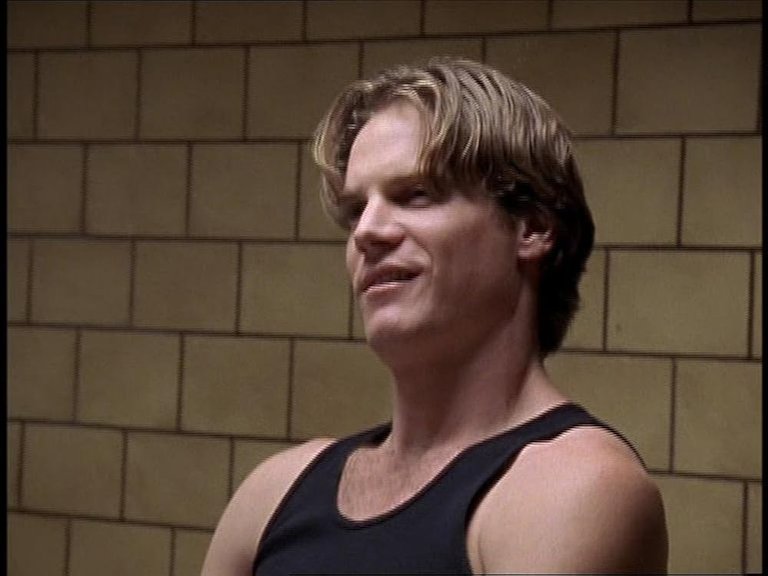Television Review: Closet Cases (Homicide: Life on the Street, S6X09, 1998)

Closet Cases (S06E09)
Airdate: 2 January 1998
Written by: Christopher Kyle
Directed by: Leslie Liebman & Larry Williams
Running Time: 46 minutes
The Homicide: Life on the Street episode Closet Cases, first broadcast in 1998, has not aged well, revealing the limitations of its ambitious but ultimately shallow approach to representation of homosexuality. While late 1990s television produced groundbreaking content that pushed boundaries, many such works now feel dated, relying on the novelty of their subjects rather than genuine depth. Closet Cases epitomises this: its central plot hinges on homosexuality, a topic barely acknowledged on mainstream American TV until short time ago, but its execution leans heavily on clichés and moralising, using the “heart in the right place” as a crutch to overlook structural flaws.
The main storyline follows detectives Pembleton and Bayliss investigating the brutal murder of a man discovered dumped in lingerie near a Baltimore restaurant popular among gay community, his face so badly damaged that identification proves challenging. The restaurant’s owner, Chris Rawls (Peter Gallagher), immediately suspects a hate crime, given the victim’s location and the violent nature of the attack. The detectives eventually identify the victim as Alan Costello, whose long-term partner, Sam Farrell (Kirk Penberthy), reveals Alan occasional use of male street hustlers, including Peter Fields (Brian Van Holt), who confesses to the killing after forcing Bayliss to compliment his physique in a cringe-inducing exchange. The subplot involving Bayliss’s sudden romantic interest in Rawls—a decision framed as an exploration of his sexuality—further complicates the narrative. Pembleton’s bafflement at his partner’s abrupt shift, coupled with Bayliss’s own eagerness to “come out” in public, undermines the scene’s sincerity, feeling instead like a gimmick to shock audiences. The episode’s climax, in which Bayliss dates Rawls, is handled with awkward haste, underscoring the show’s struggle to balance progressive themes with realistic character development.
The supporting storylines, typical of Homicide’s multi-plot structure, falter here. Falsone’s ongoing custody battle with his ex-wife, Janine (Monica Trombetta), plays out in a tired, melodramatic manner, recycling clichés about single fathers and marital strife. This subplot, part of an extended arc, lacks the nuance or emotional weight that defined the series’ earlier seasons, instead opting for predictable theatrics. Meanwhile, the continuation of the Luther Mahoney saga—already overextended—descends into soap opera tropes. Kellerman’s reluctant confession to Steevers about a non-existent incriminating tape, followed by Georgina Rae’s manipulative “twist” wherein she admitting fabricating the tape’s existence to test Kellerman’s guilt over her brother’s death, feels contrived. The resolution, in which Georgina declares her intent to seek revenge, adds little beyond gratuitous drama, distancing the episode from the grounded realism that once made Homicide stand out. These subplots, once strengths of the series, here feel forced and disconnected, bogged down by unnecessary complexity.
The episode’s treatment of gay themes, while progressive by 1990s standards, now reads as superficial and clichéd. Bayliss’s sudden interest in exploring his sexuality—a bold move for a network TV protagonist at the time—feels more like a ratings stunt than a meaningful character arc. His eagerness to announce his newfound openness to Pembleton, combined with the episode’s reliance on stereotypes—drag queens, gym-obsessed men, and the killer’s contradictory homophobia despite selling sex to men—reinforces outdated tropes. The Baltimore gay community is reduced to a series of shorthand signifiers, lacking the depth or humanity that the show applied to other marginalised groups. The killer’s motivation, rooted in internalised prejudice, is underdeveloped, serving only to sensationalise rather than illuminate. What was once groundbreaking now feels like a missed opportunity, prioritising shock value over substance.
A curious anachronism emerges in the cameo of Joe Grifasi as Lt. Neal, a character from the short-live Homicide: Second Shift web series. Launched in 1997 as a photonovel—a text-and-image format limited by its time’s technology—the web spinoff is a relic of internet infancy, and Neal’s appearance here serves no narrative purpose beyond a vague nod to continuity. Similarly, the mention of conservative US Senator Jesse Helms—a figure controversial for his staunch opposition to homosexuality—feels like a dated cultural reference, inserted to score cheap points rather than engage meaningfully with the episode’s themes.
The subplots, while typical of Homicide’s layered storytelling, here drag the episode into melodrama. Falsone’s custody drama, though acted competently, is bogged down by repetitive conflict and underdeveloped emotional stakes, while the Mahoney saga’s “twist” feels like a cheap ploy to extend a storyline that should have been resolved. The nighttime conference between detectives about Luther Mahoney’s death lacks the tension or moral ambiguity that defined earlier episodes, instead leaning into histrionics. The series’ earlier strengths—its unflinching realism, moral complexity, and nuanced characterisation—feel diluted here, replaced by tired clichés and rushed resolutions.
Ultimately, Closet Cases is a product of its time, both constrained and defined by the narrow boundaries of late-1990s TV. While its attempt to tackle gay issues with sensitivity was once notable, its execution is hampered by a reliance on stereotypes and a narrative that prioritises shock over substance. For all its ambition, the episode underscores how even well-meaning attempts at progress can falter when hampered by structural laziness and a failure to engage deeply with its subject matter.
RATING: 5/10 (++)
Blog in Croatian https://draxblog.com
Blog in English https://draxreview.wordpress.com/
InLeo blog https://inleo.io/@drax.leo
LeoDex: https://leodex.io/?ref=drax
Hiveonboard: https://hiveonboard.com?ref=drax
Rising Star game: https://www.risingstargame.com?referrer=drax
1Inch: https://1inch.exchange/#/r/0x83823d8CCB74F828148258BB4457642124b1328e
BTC donations: 1EWxiMiP6iiG9rger3NuUSd6HByaxQWafG
ETH donations: 0xB305F144323b99e6f8b1d66f5D7DE78B498C32A7
BCH donations: qpvxw0jax79lhmvlgcldkzpqanf03r9cjv8y6gtmk9